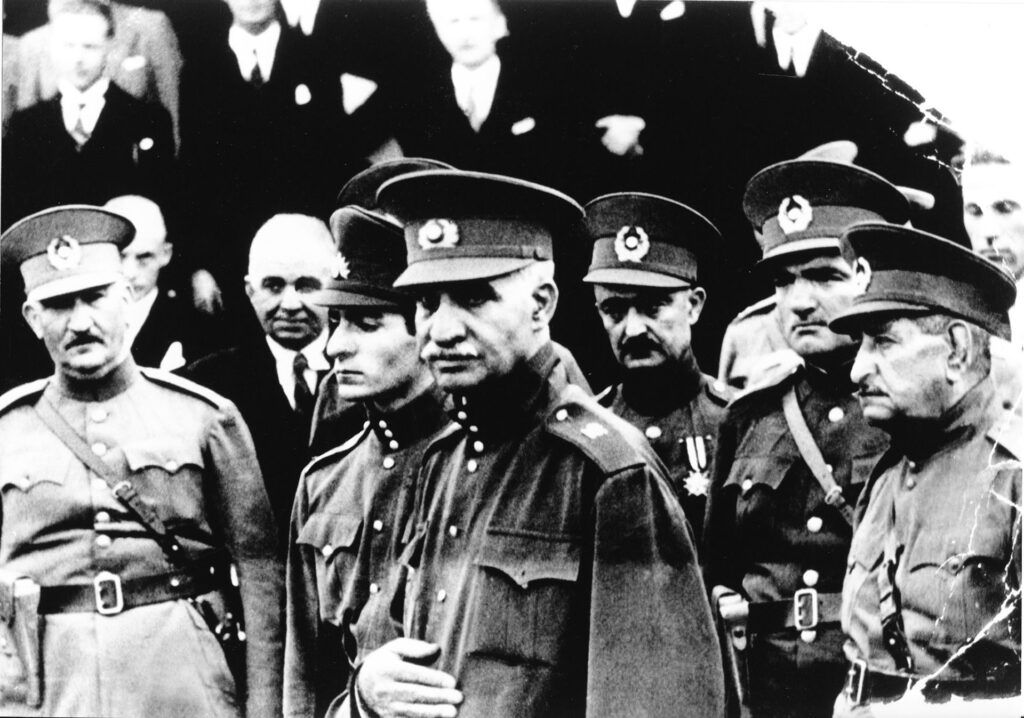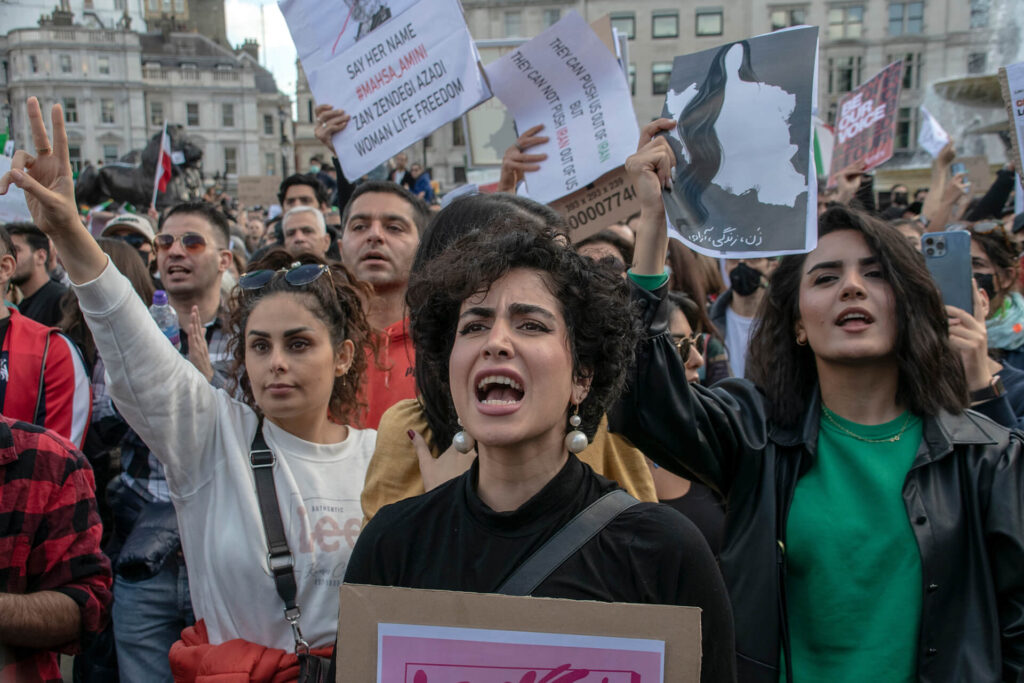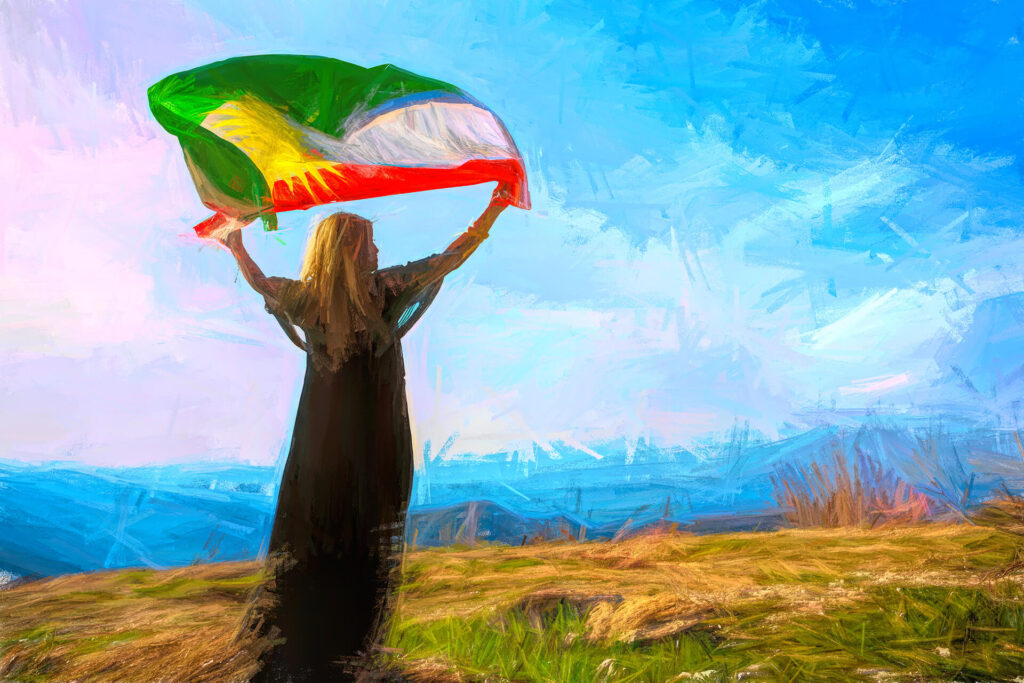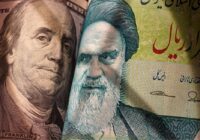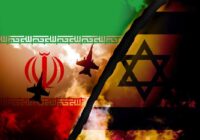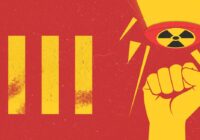Before assessing Iran’s contemporary unrest, we must challenge some popular illusions about Iran. Three in particular are:
- The 1979 Revolution – Islamic or Popular?
One common misconception is that the 1979 revolution was simply an Islamic one. In reality, the revolution was as much a popular one as it was Islamic. It involved a broad spectrum of groups and interests, some of whom were previously in conflict, now sharing a keen desire for radical change – Islamists, intellectuals, socialists, Marxists, nationalists, democrats, bazaaris, workers, technocrats, students.
In addition to ending the corruption of the Shah’s era, many of the protesters were expecting the formation of a secular parliamentary democracy with pluralistic representation, and an end to US domination. Certainly, it was the Islamic Revolutionary Party, led by Ayatollah Khomeini after his return from exile in February 1979, which eventually took control as the Islamic Republic of Iran (IRI). However, they achieved this only after ruthlessly removing during 1979 and 1980 all other political parties deemed as threats. Popular hopes and expectations for democracy and an end to corruption were soon to be dashed. Professor Ali Ansari (2006, 2019) provides details.
- Female Emancipation – Non-Existent?
Females have taken a prominent role in the anti-regime movement that took off in September 2022. On the streets, they chant: “Zahn, Zendeghi, Azadi” (or in Kurdish, “Jin, Zen, Azadi”) – Woman, Life, Freedom.
Glaring and hard-to-defend gender inequalities do exist. Nevertheless, women surprisingly possess a level of human rights and equality far greater than in many countries of the region.
An industrialized oil economy for over a century, Iran’s population has a strong work ethic. Women go out to work and occupy many posts at all levels in government, the majlis (parliament), financial institutions, public services, and companies. Across Iran’s 236 universities, female student numbers are roughly equal to males. Women have had the vote since before the IRI was formed. They drive cars without restriction.
So, what has provoked the recent explosion of anger among Iranian women and girls? At one level, it is the daily exposure to petty and banal indignities arising from the authoritarian edicts of the IRI leadership. These edicts are enforced down to every level of society by a hierarchy of loyal apparatchiks, typically the ‘Morality Police’, the Iranian Revolutionary Guard Corps (IRGC) (also known as Sepah Pasdaran), and the lower level baseeji enforcers.
For example, the highly restrictive IRI dress code forbids women and girls to wear clothing in public that does not fully cover their body, arms, and legs; they must wear a hejab or scarf to cover their head; and they must not wear ‘excessive’ make-up, sunglasses or ‘ostentatious’ jewelry.
Other restrictions, affecting both women and men, limit freedom of expression in the arts, journalism, and social media, among others. There is no press freedom. Any active support for any political parties that have not been approved by the IRI regime is also forbidden. Many individuals have been jailed or have gone into exile for transgressions. Many others have simply emigrated.
Female resentment, frustration, and anger against all such overbearing, intrusive, and patronizing micro-management have been bubbling for years. Women have become emboldened to demonstrate against what they perceive as state repression led by a bunch of finger-wagging, po-faced, grisly old men (boz-ha-ye pir or ‘old goats’). These leaders are seen as authoritarian misogynist hypocrites masquerading as benign paragons of pious rectitude.
Such a context was a slow-burning fuse looking for an accelerant, an accident waiting to happen. One was supplied in September 2022 by the death in custody of a young female protester, Mahsa Amini, under suspicious circumstances, as detailed in a later section.
- Iranians Hate the West – Or Do They?
Over the past 40 years, TV news clips exist of street crowds in Tehran chanting in unison ‘marg bar Amrika’ (death to America) and ‘marg bar Shetan-e Bozorg’ (death to the Great Satan i.e. the USA), and the burning of American and British flags, which has created an impression that the people hate the West. However, this venting by small groups of faithful supporters of the IRI bears no relation to the views of the mass population of over 86 million.
The author has personally observed in Iran that there continues to be no evidence of any popular hatred in Iran towards either the British or the American people. Iranians like and admire many aspects of the West. Many Iranians value a Western higher education and even pursue professional and business careers in the West. Even the children of the IRI leadership and its elite supporters do this on a grand scale. Anti-regime protesters have accused them of flagrant self-righteous hypocrisy by allowing their children to flout dress codes and live excessively self-indulgent lifestyles in countries that the IRI publicly vilifies.
Protests have rocked Iran continuously since last year and have spread through many cities. Thousands have taken to the streets. For once, the regime has appeared to backtrack slightly. In December, Iran’s attorney general said that the country had disbanded the morality police and was even considering changing its repressive hejab law for women. However, the protesters dismissed this move as cosmetic cynicism, since the IRGC and other forces are still enforcing the hejab law The question arises: what has triggered such an extraordinary popular upheaval?
Corruption and Plunder
Most Iranians old enough to remember the 1979 revolution have shown an ‘adapt and survive’ stoicism, a reluctance to see Iran embroiled once again in internal violence. They learned how to play the system so as to avoid being ensnared by the IRI’s repressive micro-management diktats. Indeed, a significant number simply pretended to support the IRI regime, as a cynical means to obtain favored status, privileges, access to political elites, insider commercial intelligence, and award of government contracts.
The past 40-odd years have seen a new elite of mega-wealthy opportunists, who enjoy a luxurious existence in their palatial houses in the exclusive Niavaran, Elahiyeh, and Tajrish districts of north Tehran, alongside many IRI leaders and elite functionaries and supporters.
The personal finances of the IRI leaders, and the senior commanders of their IRGC ‘security organization’, are not made public, although research suggests that Khamenei may have amassed a US$ 200 billion personal fortune. Nonetheless, in the imaginations of ordinary Iranians, the country is run by kleptocrats, who have plundered the country’s oil revenues and other public assets for their own benefit. Their lifestyle, visible assets, and suspected millions in offshore accounts have shaped an image of duplicity and greed among the elite.
Allegedly the IRGC, originally established as an elite internal national security body, has also evolved into a de facto organized crime group authorized by Ayatollah Khamenei. The IRGC has been allowed to operate with minimal controls. With little impunity, the IRGC can exercise brutality against protesters, dissidents and anyone deemed to challenge the IRI status quo as well as opportunistic abuse of state-funded activities (e.g. the bonyad charities; numerous infrastructure contractors) for personal gain. They also allegedly mastermind drug trafficking. Whatever the reality, the mass population believes the allegations.
Poverty, Neglect and Incompetence
Short periods of noisy but usually non-violent public unrest in Iran have occurred sporadically over the past 20 years. Typically, they have had specific economic causes, such as the removal of cost-of-living subsidies or fuel price subsidies, or massive overnight price-rises for staple foodstuffs. By 2017, some street protests became violent. While disorganized and uncoordinated, these protests for the first time involved overwhelmingly working-class people who, until then, were core supporters of the regime. Open calls for regime change were made. Further street protests and strikes by bazaari shopkeepers (traditionally IRI regime supporters) occurred in June and July 2018, against austerity, water shortages, and the near collapse of the currency.
On top of a national trend of increasing anger with day-to-day hardships, regional unrest has also risen. This has resulted from decades of neglect by the central authorities in Tehran. Two provinces remote from Tehran are especially affected: oil-rich Khuzestan, on the southwest border with Iraq, and Sistan-Baluchistan, on the southeast border with Pakistan.
In addition to producing more than 80% of Iran’s oil, Khuzestan sustained much damage, privation, and loss of life during the Iran-Iraq War. The port city of Khorramshahr in particular bore the brunt of 8 years of vicious close-quarters fighting and came to symbolize for Iranians the nation’s heroic struggle against foreign aggression and impossible odds. Yet, despite national recognition of such huge sacrifices, Khuzestan has been sorely neglected. While Tehran has thrived, expanded, and modernized, little has been done to regenerate cities such as Khorramshahr. Water shortages and power cuts add to the misery of unemployment, poverty, and decay, contrasted with the affluent elitist environment of Tehran. Little wonder that noisy, and increasingly violent, sporadic public protests against the authorities in Khuzestan cities since 2018 became more sustained in 2022, and have been typically suppressed by armed IRGC forces.
Sistan-Baluchistan has also suffered from the ‘out of sight, out of mind’ neglect by the IRI authorities in Tehran. In addition, the neglect has aggravated a grumbling grievance over alleged discrimination by the Shia Muslim IRI regime against the local Baluchi population. The Baluchi’s are predominantly Sunni Muslims, among whom a separatist movement has emerged.
The western Iranian province of Kurdistan is also a focus of regional unrest, although centered more on Kurdish separatism and ethno-suppression by the IRI than economic and infrastructure neglect or religious discrimination.
Brutality of State Enforcers
The major provocation that ignited the current uprising occurred on September 16, 2022, when a young hejab protester Mahsa Amini, visiting Tehran from her hometown of Saqqez in Kurdistan Province, was arrested by police for not wearing her hejab ‘correctly’ during a street protest. A short time after, police alleged that she collapsed. She was taken to hospital where she was pronounced dead. A coroner’s report concluded she died of natural causes related to a childhood illness, but her family and mass protesters insist that she was beaten by police.
Whatever the truth, public anger against the regime boiled over, with mass protests in Kurdistan province. When these were put down brutally by the IRGC, street protests rapidly spread across Iran. By late November, over 150 cities and towns were involved in demonstrations. Unprecedented mass chants of ‘death to Khamenei’ and ‘death to the dictator’ continue to echo across the nation.
The regime further inflamed matters by instructing the IRGC, baseeji, and local police to apply increasing brutality. Four days after Mahsa’s death in custody, a 16-year-old protester Nika Shakarimi was found dead on a building site after detention by police. The police claimed that she had been released unharmed and they had no knowledge of her death. Other young protesters killed by regime forces included Sarina Esmailzadeh, aged 16, and Hadis Najafi, aged 22. An increasing number of detained female protesters, and even males, have reported rape and sexual assault at the hands of law enforcement and prison officials. According to the UN, by late November at least 400 protesters including a number of children had been killed by state forces. Over 15,000 had been arrested, and an increasing number were being tried, and convicted, sentenced to death, and executed.
Public protest in Iran has now escalated to incandescent levels of rage. A quantum leap has occurred, involving unrestrained violence against any and all symbols of the regime. Smartphone video clips spread like wildfire on social media of armed police, baseeji, and IRGC personnel being attacked by unarmed mobs on a daily basis across the country. Unconfirmed reports suggest that at least four IRGC colonels have been killed so far in separate incidents. When a seminary for trainee mullahs was attacked by an enraged mob, terrified students were filmed being beaten and stripped of their robes and turbans.
The savagery and amoral conduct of the regime’s forces, cheered on by an unrepentant Ayatollah Khamenei, President Raisi, and other IRI leaders (e.g. Chief Justice Gholam-Mohseni Eje’i, his adviser Hossein Ali Nayyeri, Prosecutor General Mohammad Jafar Montazeri, and IRGC Commander-in-Chief Major General Hossein Salami), has provoked a new resolve among protesters to match their level of violence.
The failure of IRI leaders to stop the sexual abuse of detained protesters, including children, or even to publicly condemn it, is now taken as a clear sign that the regime is using rape as a terror weapon against its citizens. Since the regime has remained silent on such accusations and has failed to arrest and prosecute the state’s agents involved, it is likely that all the IRI leaders and their subordinates down to the local perpetrators would be prosecuted for these offenses by an incoming regime.
Police officers, baseeji, IRGC, and prison officers are likely to be targeted by enraged citizens, and this may well be extended to judges, the judiciary, and court officials if harsh sentences are meted out to accused protesters. High on the vengeance list will be Mohammad Mehdi Haj Mohammadi, head of the national prisons service, Gholamreza Ziaei, Director of the notorious Evin prison, and Hedayat Farzadi, Chief Warden of Evin prison. In the escalating cycle of violence, representatives of the state, their families, and property, are unlikely to receive mercy from vengeful mobs.
New Proto-Revolutionary Signs
The decades of overbearing, misogynistic IRI rule, plus the general corruption orchestrated and nurtured by the regime against the mass population, as well as hyperinflation, perpetually falling standard of living, high unemployment, US and UN sanctions, have together built up into a nationwide coalescence of different protesting sectors of society. For every protestor, there is one common enemy: the IRI regime. This coalescence mirrors that of the 1979 revolutionary build-up.
The public mood has changed strikingly in recent years. A poll by Pew Research in 2013 indicated that more than 80% of the population wanted to retain an Islamic state in some form. By 2022, polls showed that a similar proportion now want the opposite, a secular or non-religious state. This clearly indicates that the IRI had lost its moral authority and public trust. The current unrest reflects that mood change, but how does it differ from previous unrest?
The new characteristics include:
Unprecedented perseverance, severity, scale, and geographical spread of public protests: As of January 24, 2023, protests have lasted 130 days without a break and spread to over 150 cities and towns across all provinces, with crowd numbers ranging from tens to thousands.
Populist character, involving males and females of all sectors and age groups, including schoolchildren and bazaari support. High-profile Iranians (e.g. former President Khatami, Ayatollah Khamenei’s sister, TV personalities, film stars, sports champions) publicly backing the protesters. Sympathy strikes across many sectors (e.g. higher education and schools, oil & gas, petrochemicals, bazaaris and shopkeepers, and manufacturing). An effective 3-day national retail strike occurred in early December.
Demand for regime change. The spectrum of grievances has coalesced into a single overall demand that the IRI regime must go. Nothing less will do. Negotiation and compromise are no longer possible, especially given the regime’s increasingly murderous crackdown.
Lack of fear among protesters, especially the young and females, despite a high risk of injury, imprisonment, or death. Despite the lack of firearms or other weapons among protesters, they exhibit few qualms or reluctance to resist the regime’s armed enforcers.
Protesters use the internet and social media as communication and propaganda weapons against the regime, despite its attempts to block access or interfere with such use. Internet-savvy protesters are switching to VPN (virtual private networks) to thwart regime interference. Protesters have totally won a global and social media war against the regime, as well as public and political opinion globally including official UN position statements.
Violence against the regime’s suppression forces, and a preparedness of protesters to match or exceed their level of violence. Pitched battles by unarmed protesters against armed state agents. Protestors with a preparedness to kill are targeting more senior regime individuals. Attacking and taking over government offices and institutions. Tearing down of IRI signs, notices, and displays.
Police siding with protesters. In Orumiyeh, videos show police fraternizing with protesters. Although such instances are limited in number so far, many officers are unhappy with the crackdown and moral pressure from their own families to disavow the regime. They are also exhausted by months of trying to quell street confrontations.
Armed resistance, but on a small scale. Public access to firearms in Iran is limited by strict gun control. However, after the Mahsa Amini killing, some Iranian Kurds are now reportedly receiving arms and military training across the border in north-east Iraq. Elsewhere, the potential for protesters to steal or capture weaponry from local regime sources may become more salient.
Hindrances to a New Revolution
Despite the sustained eruption of Iranian public anger and bravery against the incumbent regime and a highly sympathetic global reaction, serious hindrances exist for those citizens aiming for a quick victory. These include:
No identifiable national leadership among protesters. Few credible national leaders inside Iran have emerged. One potential leader, Molavi Abdolhamid Ismaeelzahi, a leading Sunni cleric from Sistan-Baluchistan, is a popular reformist moderate in the IRI regime. Since September 2022 and the brutal IRGC crackdown, he has openly backed radical change, including an internationally-monitored national referendum on whether the regime should be retained or not, and called for regime agents who have sexually abused protesters to be prosecuted.
Crown Prince Reza Pahlavi, exiled eldest son of the last Shah, may desire a return of the monarchy, but there is little enthusiasm inside Iran, especially among all those born since the mid-1970s. Another putative leader in exile is Hamed Ismaeilion in Canada, whose wife and child were killed in 2020 when the IRGC shot down (apparently in error) a civilian airliner leaving Tehran. Although a charismatic orator, he has neither political nor state administrative experience.
Ansari (2022) suggests that potential leaders are many but remain hidden, awaiting pivotal cues before emerging publicly.
No identifiable organization to organize protests. Thus far, street protests have been largely local spontaneous outbursts of anger and rage. They have lacked any ostensible plan, organization, and objectives. These emotionally-driven ad hoc reactions and lack of discipline and focus render the protesters vulnerable to the dispersal and suppression tactics of the IRGC and baseeji.
No identifiable regime replacement or “government in waiting,” an extension of a lack so far of national leaders among protesters. To avoid economic and social chaos, an industrialized nation of 86 million people requires a credible and competent government continuously, with no lengthy hiatus during transfer of power.
Unequal firepower. Protesters lack (a) firearms, heavy weapons, ammunition, vehicles and other logistical supplies and (b) military training. Both are needed for effectively combating well-resourced and armed IRI forces.
Unequal finances. Whereas the regime has almost limitless finances, the disorganized protesters have very little and so are unable to create and sustain a credible national organization or to acquire weaponry or training.
Nevertheless, the momentum of the demand for regime change now appears unstoppable. Whether the regime’s survival capacity degrades fast or slowly, may depend on many volatile factors on the ground. Strikes, including a successful 3-day national retail strike in early December, have received wide sympathy among workers but frequently they are too poor to sustain even a temporary loss of income or too scared of losing their job. Unconfirmed reports suggest that state-owned companies are bribing workers with wage increases and other incentives to deter them from supporting regime-change strikes.
Another pivotal factor is the position and attitude of Iran’s regular armed forces (Artesh). Thus far, they have not been deployed to crush the protesters. However, they harbor a long-standing mistrust and resentment towards the IRGC and its baseeji enforcers on three main counts: (1) although the IRGC reports directly to Khamenei, it has become a de facto independent force only weakly controlled by him while also being independent of the professional regular armed forces, (2) the IRGC enjoys disproportionately high state largesse to fund weaponry and resources far beyond that of the regular armed forces, a source of deep Artesh resentment, (3) Artesh officers are reportedly contemptuous of the lax morality, organized criminal activity, and thuggish conduct of the IRGC and baseeji – observers have noted a parallel with the Wehrmacht’s contempt for Hitler’s SS.
For Khamenei and Raisi to deploy Artesh units to quell or crush the protests runs a heightened risk. Disgruntled units might refuse or even join the protesters against the IRGC, thereby potentially accelerating the IRI’s downfall. This fear may explain why, thus far, the regime has declined to deploy regular forces.
Potential Prognosis
Having recklessly brought their regime to the brink of disaster, what happens next? Iran has long proven to be very unpredictable. However, it is reasonable to posit a number of rough potential scenarios, for example:
Scenario 1: Protests subside over the next few weeks.
The increasingly brutal crackdown by the regime finally subdues the nationwide protests, as the protesters grow exhausted and terrified of dire consequences for them if they continue. Thus far, after some four months, there is scant evidence that the protesters are weakening. Estimated probability: (1=certainty; 0=impossibility): 0.2.
Scenario 2: Protests perpetuate but no early outright victory.
The protests continue unabated and even escalate in frequency, scale, spread, and ferocity. This projection becomes more likely the more that the protesters are supported by public figures and by multiple sector workers inside Iran, as well as globally by the media, governments, public protests, and UN bodies. Deployed IRI forces may be increasingly exhausted and unnerved and only barely managing to ‘hold the line’. Estimated probability: (1=certainty; 0=impossibility): 0.7.
Scenario 3: Protesters win outright victory within months, either by IRI capitulation or by elimination.
The protests escalate in frequency, scale, and ferocity, supported by a mass popular uprising and the emergence of a national leadership. Protesters with firearms appear on the streets, and some exhibit organization and military training. Protesters take over provincial government offices and utilities and take IRI officials prisoner. The regime’s repression agents are outnumbered, exhausted, and increasingly terrified of savage retribution by enraged citizens. Some refuse orders or even join the protesters, and the regular armed forces refuse to impose martial law. Without protection, the IRI regime is forced to quit. While a negotiated transfer of power to an interim government is plausible, it is unlikely the IRI Supreme Leader and fellow zealots (the akhundha-ye bozorg or ‘big hats’) could stomach such humiliation. They would also be at high risk of vengeful attacks and assassination, not to mention criminal charges. Therefore, fleeing the country would be their likely choice. Estimated probability (1=certainty; 0=impossibility): 0.5.
In a hybrid scenario, Scenario 3 evolves into Scenario 4, but at this stage whether, or how fast, that might occur is impossible to judge. If this scenario unfolds, by then the estimated probability of regime collapse rises to 0.8.
The regime’s fear of losing both legitimacy and control of law and order should not be underestimated, given that savage retribution by aggrieved citizens is highly likely. Moreover, an incoming regime is likely to prosecute many of the IRI regime (who escape mob justice) for waging war on its own citizens, crimes against humanity, destruction of property, and not to mention wholesale plundering of state finances and assets for their own personal gain.
With such a horrifying prospect, an early sign that the IRI regime may be on the skids are reports of oligarchs, IRGC senior officers, and IRI ‘big hats’ organizing their exile early rather than risk getting caught. Venezuela appears to be their popular choice. A further sign will be the sudden unexplained absence of prominent individuals from public life. Apart from Venezuela, there are few countries that would be willing to offer sanctuary to such pariahs. Even in Venezuela, where assassins may be hired cheaply, their safety may be illusory.
The IRI regime’s leaders and nomenklatura have finally lost any claim to legitimacy and moral authority. Thus far, they have managed to cling to power through ruthless repression. However, the legendary stoicism of the Iranian people has evaporated. Nothing less than regime change and secular governance will now be acceptable. It is no longer whether but when this transition occurs. The regime could have heeded public dissatisfaction with its governance, and chosen to moderate its authoritarian excesses. Instead, they have brought about their own likely demise.
A final caveat. Although desperate for secular democracy, and having an admiration for many things Western, the mass population will not welcome a return to foreign, particularly US, domination of their government, economy, and oil, as in the Shah’s era. A new realpolitik between the West and Iran would be essential.[Naveed Ahsan edited this piece.]
The views expressed in this article are the author’s own and do not necessarily reflect Fair Observer’s editorial policy.
Support Fair Observer
We rely on your support for our independence, diversity and quality.
For more than 10 years, Fair Observer has been free, fair and independent. No billionaire owns us, no advertisers control us. We are a reader-supported nonprofit. Unlike many other publications, we keep our content free for readers regardless of where they live or whether they can afford to pay. We have no paywalls and no ads.
In the post-truth era of fake news, echo chambers and filter bubbles, we publish a plurality of perspectives from around the world. Anyone can publish with us, but everyone goes through a rigorous editorial process. So, you get fact-checked, well-reasoned content instead of noise.
We publish 2,500+ voices from 90+ countries. We also conduct education and training programs
on subjects ranging from digital media and journalism to writing and critical thinking. This
doesn’t come cheap. Servers, editors, trainers and web developers cost
money.
Please consider supporting us on a regular basis as a recurring donor or a
sustaining member.
Will you support FO’s journalism?
We rely on your support for our independence, diversity and quality.





